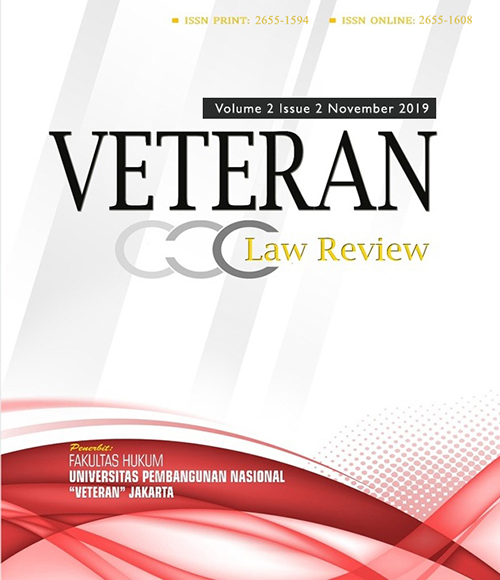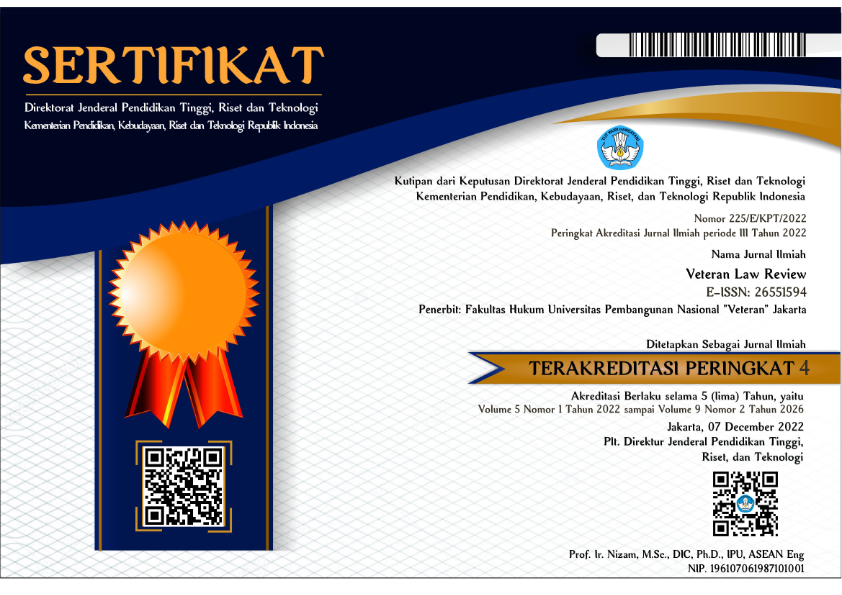The Constitutional Design Of Application Of Overseas Citizenship Of India (OCI) In The Indonesia Constitutional Law System
DOI:
https://doi.org/10.35586/velrev.v2i2.759Abstract
The idea of implementing a dual citizenship system in Indonesia which was initiated by the Indonesian Diaspora was directed towards imitating the Overseas Citizenship Of India (OCI) concept in India. The concept is considered a middle way between the demands of the Indian Diaspora and the reluctance of the Indian Government to amend the constitution regarding the principle of single citizenship. Indonesia also currently applies a single citizenship principle even though it is not regulated in the constitution. The idea of an Indonesian diaspora to emulate the OCI concept in India looks very rational, except that the problem is the extent to which the concept is applicable in the Indonesian constitutional system. What rules must be changed and which provisions must adjust. Implications of the application of OCI can be the same as dual citizenship, because the theory used is a residual theory where, apart from the prescribed restrictions, OCI card holders must be considered equal to Indonesian citizens. This concept has the potential to create legal complexity if there is a legal difference between Indonesia and other countries.
Downloads
References
Asshidiqie, Jimly. (2007), Pokok-Pokok Hukum Tata Negara Indonesia, Jakarta:PT Bhuana Ilmu Populer.
Naujoks, Daniel.(2013). Migration, Citizenship, and Development. Diasporic Membership Policies and Overseas Indians in the United States, New Delhi: Oxford University Press.
Binod Khadria. (2009). Adversary Analysis and the Quest for Global Development Optimizing the Dynamic Conflict of Interest in Transnational Migration, Social Analysis, Volume 53, Issue 3, 106–122
M. Beni Kurniawan. (2018). Penggunaan Diskresi Dalam Pemberian Status Kewarganegaraan Indonesia Terhadap Archandra Thahar Ditinjau Dari Asas Pemerintahan Yang Baik, Jurnal Penelitian Hukum De Jure, Vol. 18 No. 2. 149 - 162
Rokilah. (2017). Implikasi Kewarganegaraan Ganda Bagi Warga Negara Indonesia, Jurnal Ajudikasi .Vol.1 No.2, 53-62
Lisong Liu, (2012): Return Migration and Selective Citizenship A Study of Returning Chinese Professional Migrants from the United States, Journal of Asian American Studies; Baltimore Vol. 15, Iss. 1. 35-68
Sharad K. Soni, (2000). The United Nations Commission On Human Rights (55th Session) : A Report, Himalayan and Central Asian Studies,Vol. 4 No. 2,H.35
Sejersen, Tanja Brøndsted,(2008). I Vow to Thee My Countries" - The Expansion of Dual Citizenship in the 21st Century: IMR IMR, The International Migration Review, 42
Jum Aggriani (2012), Penerapan Asas Nasionalitas dalam Perundang-undangan Agraria Indonesia, Studi Kasus PP No.40 Tahun 1996, Jurnal Dinamika Hukum Vol.12 No.1, Hal.124
https://tirto.id/saat-diaspora-indonesia-menuntut-kewarganegaraan-ganda-crPo diakses pada tanggal 12 April 2019
http://dlgimmigration.com/united-states-citizenship/countries-that-allow-dual-citizenship/ diakses pada tanggal 12 April 2019
https://vittana.org/16-big-pros-and-cons-of-dual-citizenship diakses pada tanggal 7 April 2019
https://web.archive.org/web/20170422124533/https://in.usembassy.gov/u-s-citizen-services/citizenship-services/dual-nationality/ diakses pada tanggal 10 April 2019
https://ociservices.gov.in/ diakses pada tanggal 10 April 2019
https://www.ndtv.com/indians-abroad/supreme-court-dismisses-plea-for-voting-rights-of-overseas-citizens-756654 diakses pada tanggal 10 April 2019
https://money.kompas.com/read/2015/09/16/134501326/OJK.Terbitkan.Aturan.Penyederhanaan.Buka.Rekening.Bank.untuk.WNA diakses pada tanggal 12 April 2019
Downloads
Published
How to Cite
Issue
Section
License
Copyright (c) 2022 Veteran Law Review Journal
Veteran Law Review © 2022 by Faculty of Law Universitas Pembangunan Nasional "Veteran" Jakarta is licensed under Creative Commons Attribution 4.0 International

1. License
The non-commercial use of the article will be governed by the Creative Commons Attribution license as currently displayed on Creative Commons Attribution 4.0 International.
2. Author(s)' Warranties
The author warrants that the article is original, written by the stated author(s), has not been published before, contains no unlawful statements, does not infringe the rights of others, is subject to copyright that is vested exclusively in the author, and free of any third party rights, and that any necessary written permissions to quote from other sources have been obtained by the author(s).
3. User/Public Rights
VELREV's spirit is to disseminate articles published are as free as possible. Under the Creative Commons Attribution-ShareAlike 4.0 International License. VELREV permits users to copy, distribute, display, and perform the work for non-commercial purposes only. Users will also need to attribute authors and VELREV to distributing works in the journal and other media of publications.
4. Rights of Authors
Authors retain all their rights to the published works, such as (but not limited to) the following rights;
- Reproduce the work
- Prepare derivative works based upon the work
- Distribute copies of the work
- Perform the work publicly
- Display the work publicly
- Copyright and other proprietary rights relating to the article, such as patent rights,
- The right to self-archive the article,
- The right to enter into separate, additional contractual arrangements for the non-exclusive distribution of the article's published version (e.g., post it to an institutional repository or publish it in a book), with an acknowledgement of its initial publication in this journal (Veteran Law Review).
5. Co-Authorship
If the article was jointly prepared by more than one author, any author submitting the manuscript warrants that he/she has been authorized by all co-authors to be agreed on this copyright and license notice (agreement) on their behalf, and agrees to inform his/her co-authors of the terms of this policy. VELREV will not be held liable for anything that may arise due to the author's internal dispute. VELREV will only communicate with the corresponding author.
6. Royalties
Being an open accessed journal and disseminating articles for free under the Creative Commons license term mentioned, author(s) are aware that VELREV entitles the author(s) to no royalties or other fees.
7. Miscellaneous
VELREV will publish the article (or have it published) in the journal if the article’s editorial process is successfully completed. JOSI's editors may modify the article to a style of punctuation, spelling, capitalization, referencing, and usage that deems appropriate. The author acknowledges that the article may be published so that it will be publicly accessible and such access will be free of charge for the readers as mentioned in point 3.


















